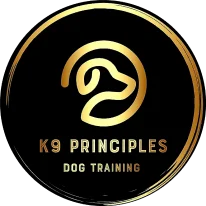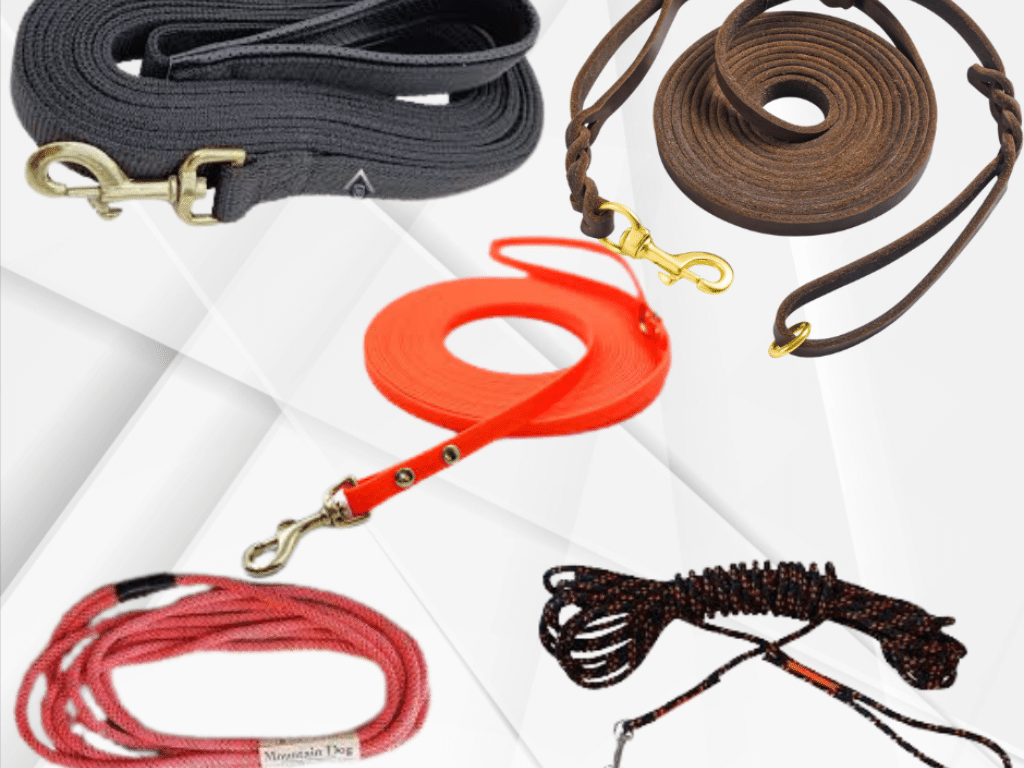If you’re a dog owner in Hamilton, you may have heard about the long line, a simple yet incredibly effective training tool that can transform your dog’s behaviour. Whether you’re new to dog training or looking for ways to enhance your dog’s obedience, the long line offers a perfect blend of control and freedom. This guide will walk you through everything you need to know about using a long line, particularly in the context of dog training in Hamilton. By the end of this article, you’ll understand why the long line is considered an invaluable tool by your professional dog trainers that are endorsed by the Hamilton/Burlington SPCA, K9 Principles.
What is a Long Line?
A long line is essentially an extended leash, ranging from 5 to 10 metres (15-30 feet), made from materials like nylon, cotton, or biothane. Unlike standard leashes, which typically measure around 1 to 2 metres, long lines offer your dog the freedom to explore while you maintain control. They are particularly useful in training scenarios and are a staple in the toolkits of professional trainers like those at K9 Principles, who specialise in Hamilton dog training.
Why Choose a Long Line?
Choosing a long line for your dog training sessions in Hamilton provides numerous benefits. It’s not just an elongated leash; it’s a versatile tool that can be used in various training contexts. Whether you’re working on recall, allowing your dog to explore safely, or helping a nervous dog build confidence, a long line gives you the flexibility and control needed to achieve your training goals.
The Benefits of Using a Long Line
Improved Recall Training
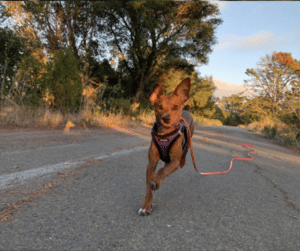 When it comes to dog training in Hamilton, recall is one of the most crucial commands to master. The long line is an excellent tool for this purpose. It allows your dog the freedom to wander while still keeping them within your control. If your dog hesitates to return when called, a gentle tug on the long line can reinforce the cues. Over time, this consistent practice helps build a reliable recall, ensuring your dog’s safety in various environments.
When it comes to dog training in Hamilton, recall is one of the most crucial commands to master. The long line is an excellent tool for this purpose. It allows your dog the freedom to wander while still keeping them within your control. If your dog hesitates to return when called, a gentle tug on the long line can reinforce the cues. Over time, this consistent practice helps build a reliable recall, ensuring your dog’s safety in various environments.
Safe Exploration for Dogs
Hamilton offers a variety of parks and open spaces where your dog can explore. A long line lets your dog indulge in this natural curiosity without the risk of running off. This is particularly beneficial in areas like Bayfront Park or the Hamilton Waterfront, where your dog can enjoy the scenery while staying safely within your reach. The long line provides a controlled environment where your dog can explore, sniff, and roam, which is essential for their mental stimulation and overall well-being. 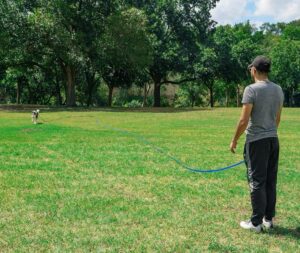
Enhancing Confidence in Nervous Dogs
For dogs that are nervous or anxious, especially in new environments like the busy streets of Hamilton, a long line can be a confidence booster. The extra length allows them to explore at their own pace, which can help them feel more secure. This gradual exposure is crucial for helping a nervous dog acclimate to new surroundings, and it’s a technique often recommended by the experts at K9 Principles.
Preventing Pulling on Walks
If your dog tends to pull on the leash during walks, the long line can help address this issue. By giving your dog more room to move, you can reduce the tension that typically causes pulling. This is particularly useful when walking in busy areas of Hamilton, where your dog might be tempted to pull towards distractions. With the guidance of K9 Principles, you can learn to use the long line to teach your dog to walk calmly and respectfully, making your walks more enjoyable.
How to Properly Use a Long Line
To get the most out of your long line during Hamilton dog training sessions, it’s essential to use it correctly. Here are some tips to help you make the most of this versatile tool.
Choosing the Right Length
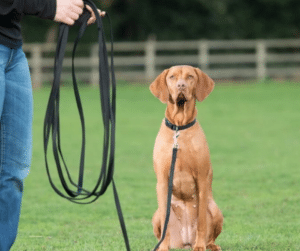 The length of the long line you choose depends on the environment and your training goals. For urban settings or areas with more distractions, a shorter line (around 5 metres) might be more manageable at the beginning stages of training in a new environment. In more open spaces like the Dundas Valley Conservation Area, a longer line (10-15 metres) allows for greater freedom while still maintaining control.
The length of the long line you choose depends on the environment and your training goals. For urban settings or areas with more distractions, a shorter line (around 5 metres) might be more manageable at the beginning stages of training in a new environment. In more open spaces like the Dundas Valley Conservation Area, a longer line (10-15 metres) allows for greater freedom while still maintaining control.
Safe Handling Techniques
Using a long line requires some practice. Always hold the line loosely but securely, and be mindful of your surroundings to avoid entanglements. It’s best to start in an open area where you and your dog can get used to the extra length without the risk of getting tangled in obstacles. This safe handling technique is something you’ll often see demonstrated by our dog training professionals at K9 Principles.
Training Tips with a Long Line
Starting with Basic Commands
When beginning dog training in Hamilton with a long line, it’s best to start with basic commands like sit, stay, and recall. The long line allows you to maintain control while gradually increasing the distance between you and your dog. This is especially useful in environments with moderate distractions, such as the many parks around Hamilton.
Gradual Distance Increase
As your dog becomes more comfortable with the long line, you can start to increase the distance. This is crucial for advanced recall training and helps your dog learn to respond to commands from a distance. The gradual increase in distance mimics real-world situations where your dog might be off-leash, making the long line an excellent tool for transitioning to off-leash behaviour.
Incorporating Distractions
Hamilton is a vibrant city with plenty of distractions for your dog, from other animals to the hustle and bustle of city life. Using a long line, you can train your dog to stay focused on your cues even in distracting environments. This type of training is particularly effective when working with K9 Principles, who specialise in distraction-proofing your dog’s behaviour through our in-home private training.
Common Mistakes to Avoid
Using a Long Line Without Supervision
One of the most common mistakes in Hamilton dog training is leaving a dog unsupervised on a long line. This can lead to entanglements or injuries, especially in busy or densely vegetated areas. Always supervise your dog when using a long line to ensure their safety and the effectiveness of your training.
Misjudging the Terrain
Hamilton’s diverse terrain offers various challenges, from urban streets to wooded trails. It’s important to choose the right environment for long line training. Avoid areas with dense vegetation or heavy foot traffic, as these can increase the risk of entanglement. Open, flat spaces are ideal for practising with a long line.
Neglecting Regular Checks for Wear and Tear
Long lines, like any piece of equipment, require regular maintenance. Over time, the line can wear out, especially if used frequently or in rough conditions. Regularly inspect the line for fraying or weakening to ensure it remains safe for use.
Long Line vs. Retractable Leash
Differences in Control
When comparing a long line to a retractable leash, the long line offers more consistent control, especially in training scenarios. A retractable leash can create inconsistent tension, making it harder to manage your dog effectively. This makes the long line a superior tool for training, as it allows you to maintain a steady level of control at all times.
Safety Considerations
Retractable leashes can pose several safety risks, such as sudden retraction or the potential for the thin cord to cause injuries. In contrast, a long line is thicker and more durable, reducing these risks and providing a safer alternative for both you and your dog during training sessions.
Training Effectiveness
The long line is particularly effective for training purposes, allowing for gradual distance training and control over distractions. Unlike retractable leashes, which can hinder consistent training, a long line provides the flexibility needed to reinforce cues and build solid behaviour. This is why K9 Principles prefer long lines for training over other leash types.
When Not to Use a Long Line
Unsuitable Environments
Not every environment is suitable for long line use. Urban areas with heavy traffic or densely wooded areas with lots of obstacles can be risky. It’s better to use a long line in open spaces where you can easily manage the extra length, ensuring both you and your dog remain safe.
With Untrained Dogs
A long line may be overwhelming for dogs that have not yet mastered basic commands. It’s important to start with a standard leash and build up to a long line as your dog becomes more responsive. This foundational training is something the experts at K9 Principles strongly recommend and can help you with in our level 1 group classes or our in-home private training.
During High-Intensity Play
During high-energy activities, such as fetch or play with other dogs, a long line can become a hazard. The risk of entanglement or injury increases significantly, so it’s better to use the long line for controlled activities like walking or training.
Conclusion
Incorporating a long line into your dog training in Hamilton routine can make a significant difference in how you manage and enjoy your time with your dog. It provides a perfect balance of control and freedom, making it an invaluable tool for improving recall, building confidence, and allowing safe exploration. By understanding how to use a long line effectively, you can enhance your dog’s training and overall experience, leading to a happier and more well-behaved companion. Whether you’re just starting your dog training journey or looking to refine your dog’s behaviour, the long line is an essential tool that every dog owner should consider. The benefits of using a long line, from improving recall to providing safe exploration opportunities, are numerous and can significantly enhance the bond between you and your dog. By following the guidelines and tips provided, you can ensure that you’re using the long line effectively and safely.
- Name: K9 Principles
- Address: Haldimand County, Greater Hamilton Area, Burlington and Most of Norfolk County
- Phone: 289 880-3382
- Email: k9principlesinc@gmail.com
- Website: www.k9principles.ca
FAQs
-
Yes, a long line can be used in urban areas, but it’s essential to choose the right environment. Open spaces such as parks or less crowded areas are ideal. In busy streets, a shorter long line might be more manageable, but always be mindful of potential hazards like traffic and other pedestrians.



